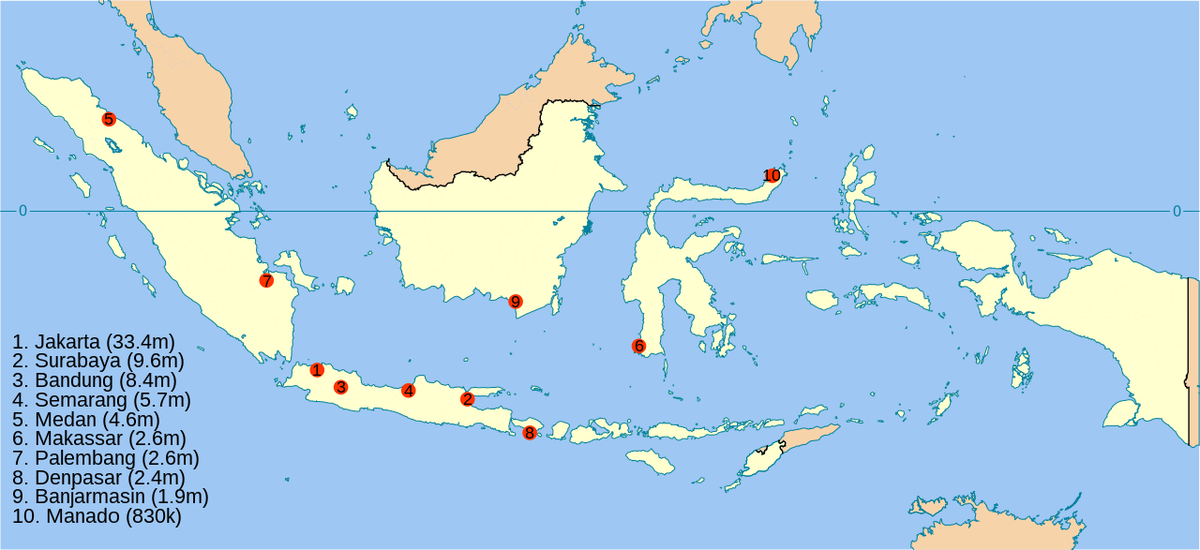The August 21 announcement that Indonesia will buy 24 F-15EX fighters from Boeing
BA
Indonesia, with a population of 280 million, is the world’s third largest democracy (after India and the US). In dollar terms it has the world’s 16th largest economy, but adjusting for the domestic purchasing power of the Indonesian currency, it actually ranks among the top ten economies.
Geopolitically, the island nation occupies a strategic position astride major shipping routes in Southeast Asia, and is a source of critical minerals such as nickel.
Although somewhat buffered from Beijing’s aggressive policies in the South China Sea by Malaysia and the Philippines, Jakarta has had its share of run-ins with the Chinese Navy and now is moving to strengthen its military.
The F-15EX will play a pivotal role in that move, because the twin-engine fighter is capable of carrying 15 tons of external ordnance and fuel to a combat range of 800 miles. That far outclasses the payload and range of the country’s single-engine fighters. F-15 also offers the advantage of never having been defeated in combat.
As the map above indicates, Indonesia faces an unusual challenge in defending its territory, which consists of 17,000 islands scattered across millions of square miles of ocean. It gets along well with most of its neighbors, but like other countries in the region has become concerned with China’s increasingly assertive foreign policy.
This has provided an opening for the Biden administration to cement relations with the nation, completing a chain of partnerships with all of the democracies in the region.
Biden administration strategy for the Indo-Pacific stresses the importance of regional partnerships, and it has made steady progress in isolating China—thanks in large part to Beijing’s heavy-handed dealings with local governments.
None of this, though, required Jakarta to buy the F-15. It could have opted for other tactical aircraft, and in fact had previously entered a deal to buy Rafale fighters from the French company Dassault. The decision to buy the EX, also known as Eagle II, thus qualifies as a significant marketing achievement for Boeing Defense.
The US State Department disclosed in February of 2022 that Indonesia was contemplating purchase of up to 36 F-15EX at a projected price of $13.9 billion, presumably including the cost of spare parts and other support.
The deal announced August 21 was for 24 of the fighters, but industry sources say the number will likely reach at least 36 once budget constraints are resolved in coming years.
As if to signal that officially non-aligned Indonesia is now firmly partnered with Washington, only two days after the fighter sale was disclosed Jakarta agreed to buy two dozen S-70M Black Hawk military helicopters from the Sikorsky unit of Lockheed Martin
LMT
Boeing and Lockheed both contribute to my think tank.
The F-15 has been operated by the US Air Force and half a dozen other nations for many years, but the EX variant being bought by Indonesia (officially designated F-15IDN) is a greatly enhanced combat aircraft with a digital backbone, state-of-the-art radar, and advanced electronic warfare suite capable of detecting and countering diverse threats.
BAE Systems designed the electronic-warfare system to meet the exacting demands of the US Air Force, which surprised the industry several years ago by deciding to buy a digital version of the fighter to modernize its aging F-15 air-superiority fleet.
The Air Force’s 2024 budget request seeks funding for 24 more of the EX variants, taking its total buy so far to 104 aircraft. Industry sources say the total buy will likely reach 150, which would be remarkable given all the other modernization initiatives the Air Force has under way.
Boeing is a viable contender for one of those initiatives, a sixth-generation fighter dubbed Next Generation Air Dominance. With Northrop Grumman
NOC
But the Air Force likes to spread its bets around, and Lockheed is already building the F-35 fighter with great success.
Against that backdrop, additional sales of the F-15EX provide Boeing with a potential bridge to the future—a way of keeping its engineering and touch-labor workforce engaged until the sixth-gen fighter enters production.
The company believes there is solid potential for EX sales to Israel, Qatar and Saudi Arabia, all of which are looking to upgrade their existing fighter fleets. It is also in preliminary discussions with Poland and Thailand. Other overseas customers may emerge.
So, Indonesia’s purchase of the F-15EX has both geopolitical and industrial-base implications for the US. The deal must receive final approval from the US government, but that appears to be a given since it is a win-win situation for all the parties involved.
The only loser is China, which once again is facing a diplomatic setback in the region as countries unite to resist its overreaching foreign policy. The Biden administration deserves credit for seeing the stakes clearly and aligning America with other democracies in defense of freedom.
As noted above, Boeing and Lockheed Martin contribute to my think tank.
Read the full article here





